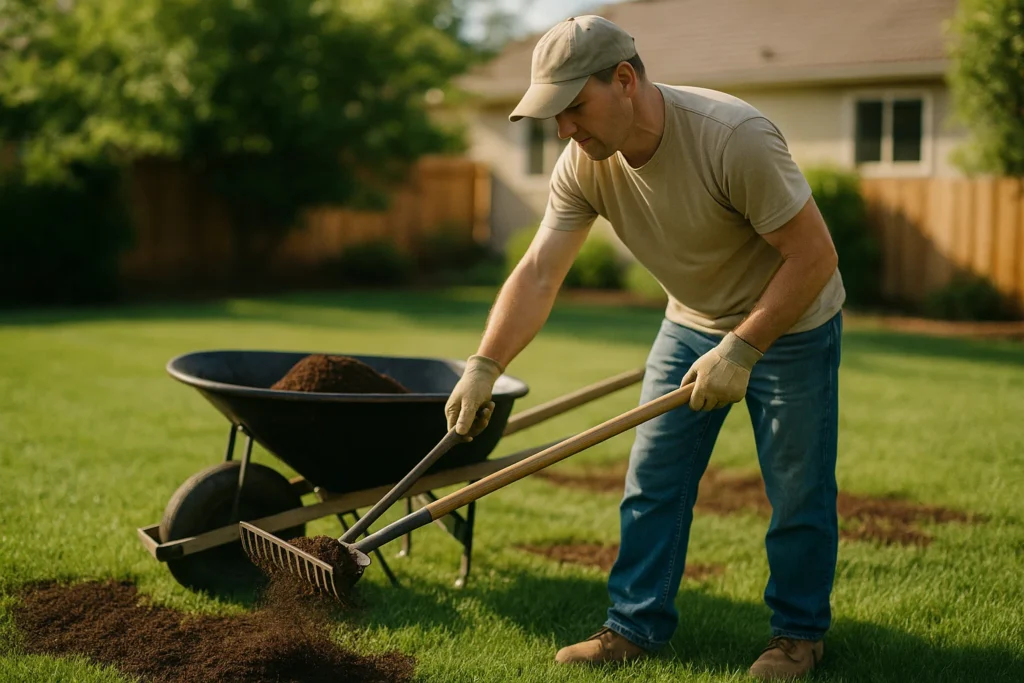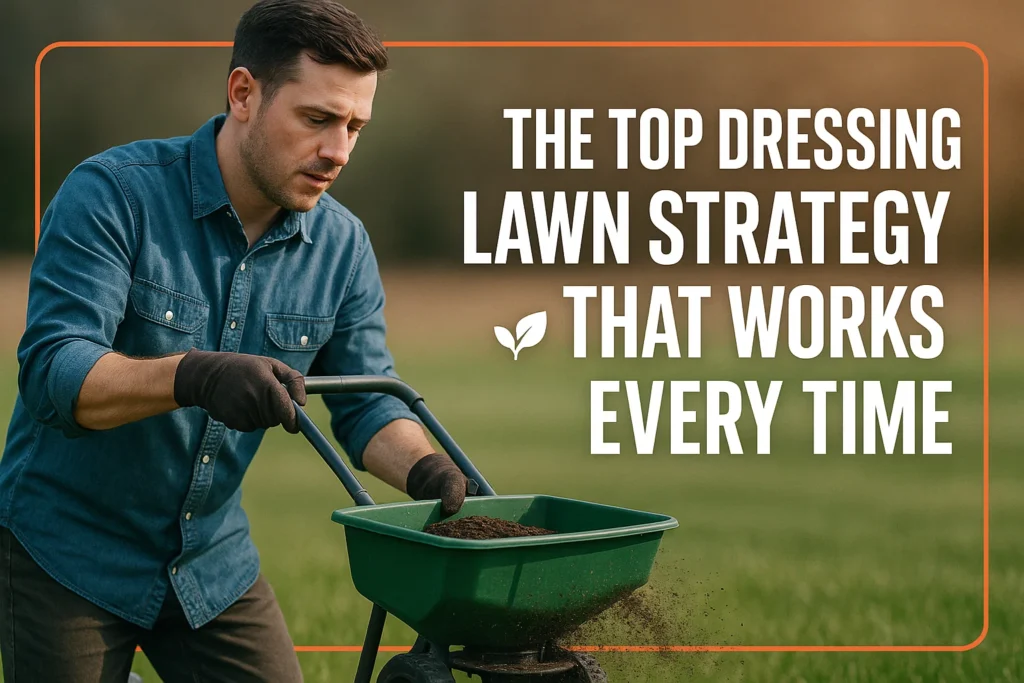Top dressing a lawn is a procedure of adding a thin layer of soil, compost, sand or a combination of them to the surface of your lawn to enhance the health, look, and the overall growing conditions of your lawn. The method is useful in improving the soil quality and seed germination. But how? In this guide, we are covering a good technique or strategy for topping a lawn.
What Is Top Dressing?
Top dressing is the process of applying a small layer of soil, compost, sand or a combination of any of such materials onto the surface of your lawn. It is a rather basic, but efficient method that enhances the quality of soil, promotes the growth of healthy grass and smooths irregular surfaces. It increases water retention, aeration and microbial activity by supplying organic matter and nutrients. Overall, top dressing supports stronger roots and results in a greener, healthier lawn.
Best Way to Top Dress the Lawn:
Top dressing the lawn is a necessary method to enhance the health of the soil, smooth the rough surfaces and make the grass grow lush. This is a practice that will help you to achieve a healthy and green lawn each season:
1. Warm Up Your Lawn
- Mow the grass and do not scalp.
- Remove the debris, grass clipping and thatch such that there is a superb contact of the dressing and the soil.
- To relieve the compression and to create the spaces where the nutrients and the water can enter deeply, aerate the lawn.
2. The Best Top-Dressing Mix to Use
Apply the combination suitable to your soil:
- Sand-dominant mix should be used to improve drainage in case of clay soils.
- In the sandy types, use more organic matter and keep them wet.
- Loam soils have the best combination of topsoil, compost and sand.
- There are also pre-mixed top dressing blends to make it convenient.
- The most popular mix to do on your own is 70 per cent sand and 30 per cent top soil to allow good drainage and structure, often with organic matter as well
3. The Dressing should be dressed accordingly
- Apply the mix on the lawn generously, but not very thick, 1/4 to 1/2 inch.
- Small lawns are to be carried out using a shovel and big lawns using a top dressing spreader.
- Never heap the earth over the grass, but rake it in, with a rake, or brush or broom, down into the blades, and the ground.
- And so with lumpy lawns: do in layers- 12mm (1/2 inch), perhaps, at a time on lawns that are not too even; hollow places must be filled and the dressing in stages.
4. Top up Overseeding Where it is Required

- After top dressing, overseed bare or thinning patches.
- The dressing creates an ideal seedbed and this prevents seeds from drying and attacks by birds.
5. Save Your Water and Lawn
- Top dressing of the water must be followed by deep watering to settle the material.
- The lawn must be kept wet so that the seed can germinate and get incorporated into the soil.
- The grass should not be mowed at all within a week or preferably two weeks so that it recovers.
6. Quantity:
Normally, 2-4 kg of lawn dressing per square meter is enough. The uneven grounds or lawns with deep depressions may need a heavier dressing but top dressing should be in thin layers
7. Every year or when necessary
The health and look of the lawn are kept by top dressing once a year, preferably in autumn in the case of cool-season grasses or in spring in the case of warm-season grasses.
Other Tips:
- Wear clothes only when the weather is not wet enough to wash away material and be able to do the job before rain.
- Top dressing regularly once a year or twice a year will enhance the health of the lawn in the long run, though excessive top dressing in one sitting should be avoided.
- Pamper the soil by adjusting the pH and top dressing it.
This is a strategy recommended by lawn care professionals and experts in gardening and it works in different conditions when applied properly
Key Benefits of Top Dressing a Lawn:
- Improves the soil quality and structure: top dressing will add organic matter to your soil that will be full of nutrients; this may be compost or peat moss. This increases the fertility of the soil, water holding capacity, and aeration to provide the best conditions for the roots of the grass can grow.
- Increases Nutrient accessibility: The soil nutrients like nitrogen, phosphorus and potassium get exhausted with time. These are the vital nutrients that are replaced by top dressing so that the grass becomes greener and healthier.
- Uneven Lawns: Uneven lawns could also be filled in order to make it smooth and beautiful and get rid of/ reduce the effects of uneven grounds. This also improves drainage and reduces any potential erosion.
- Enhances germination and overseeding: Top dressing when overseeding gives the seeds a perfect seedbed that keeps off birds and prevents drying out, besides giving the seedlings the nutrients they need to grow.
- Reduces Thatch and Increases Good Microbes: The organic materials stimulate microorganisms that reduce the mats of dead grass in the thatch and enable the water and air to percolate.
- Soil Microbe Activity: Compost and organic matter will boost the good soil microbes to help them cycle the nutrients and provide disease resistance in your yard.
What is the Best Time to Dress Lawn?
- Cool-Season Grasses: The best time to do this would be early to mid-fall because the grass is not growing as fast as it did during the summer but summer stress is over.
- Warm-Season Grasses: Top dressing would be done in spring to overlap in times of active growth of the warm-season grasses.
- Top dressing should not be done during dormant seasons or at times when it is too hot/dry.
Topsoil Vs Top Dressing
Topsoil is just soil that is laid over the lawn to be used in leveling or covering things up.
Top dressing applies a well-mixed blend to enhance soil quality, structure, and nutrient level as well as to improve turf health.
| Aspect | Topsoil | Top Dressing |
| Defination | Plain soil is used to level or fill. | A blended mix to improve soil and lawn health. |
| Purpose | Level uneven ground or cover bare spots. | Enhance soil quality, nutrients, and turf growth. |
| Composition | Natural soil, variable quality. | Mix of topsoil, sand, and organic matter. |
| Effect | Physical leveling only. | Improves soil structure and promotes healthy grass. |
| Application | Applied it thicker to fill holes. | Thin layer (¼ to ½ inch) to avoid smothering grass. |
Common Mistakes to Avoid When Top Dressing
Using Too Thick a Layer: More than 1/2 inches is suffocating, blocking light and oxygen and eventually causing damage to the lawn.
Wrong Material: Top dressings require different top dressings depending on soil. The following are examples: Heavy clay blends with pure sand on clay soil and sandy soil; sandy soil causes drainage or compaction.
Omission of Aeration: Omitting aeration prior to top-dressing lowers the performance. Compacted soil is loosened with aeration that enables the penetration of the dressing and enhancement of structure.
Top Dressing the Wrong Time: Top Dressing during the dormancy period or at excessive heat/dry periods is stressful to the grass and it inhibits recovery. The best results occur when the grass is growing.
Forgetting Aftercare: The seeds will get dry and the nutrients will not get taken up through ignoring.
Not Overseeding When Necessary: When you find bare or thin sections, you can skip overseeding that follows top-dressing, and you miss the opportunity to build up grass and avoid weeds.
These mistakes can be avoided so that top-dressing will provide the maximum benefits to the lawn in terms of health and appearance.
Conclusion
Top dressing is a reasonable and economical method of looking after your lawn and may be adopted to restore weary, hillside or thin lawns by perfecting the soil, smoothing away surfaces and promoting luxuriant growth of grass. No matter which method you decide to use, whether doing it yourself or paying someone to do it, Revamping Lawns the proper choice of material and its application can give you a greener, healthier lawn that is better able to resist stress and disease.
FAQ’s
The top dressing should be done when the grass is actively growing, which is in spring in the case of warm-season grasses and in autumn in the case of cool-season grasses, to guarantee fast recovery and good nutrient absorption
A 1/4 inch to 1/2 inch thick is recommended. Thicker layers may smother grass and growth may be affected.
Before top dressing, aeration enhances the penetration of nutrients in the soil and lessens compaction, which is why it is very advisable, particularly on heavy clay soils.
Weeds and moss will never be killed by top dressing. Those problems are better treated individually and then the top dressing is done to have a healthy lawn.
The top dressing is the process of laying soil or organic matter on the lawn. The practice of planting grass seed to thicken the lawn is called overseeding. Such practices are usually combined to produce the best results.
Garden soil may not be free of weeds and may not be of the right texture. Apply a good sandy loam or a top dressing mix that is made out of a lawn mixture to achieve the best results.



